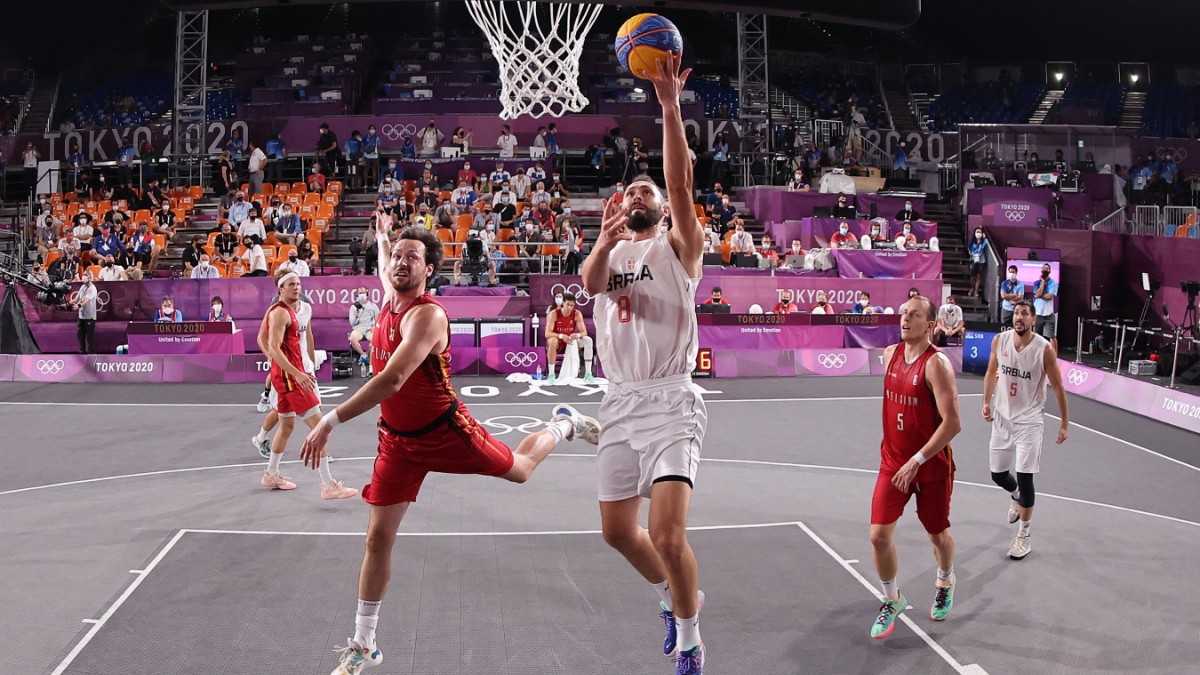The Aomi Urban Sports Park is located on one of the artificial islands of the Tokyo waterfront. It’s one of those sports venues that will disappear after the games. Tubular steel stands next to functional tents. Not far away is an Olympic fan mile, which is now waiting colorfully and empty for the end of the pandemic games. Everything that is set up here exudes a strange defiance. As if it was enough just to be there to have meaning.
But you can’t say that nothing was going on. On the contrary. TV crews and journalists are there. The spacious press tent is well attended, as are the press stands in the small provisional stadium. Most of the bucket seats in the arena are unoccupied, but a non-stop beat comes out of the boxes and commentators cheer. And there is a lot of movement on the small square with the basketball hoop anyway. The first Olympic tournament in 3×3 basketball is underway. Team USA wins the women’s final against Russia, Team Latvia the men’s, also against Russia.
There are many premieres at these games. Some of them have already been successful. On Tuesday there were the first medals in surfing, before that the skateboarders entered the Olympic stage for the first time. Sport climbing is next week. Olympia opens. Exciting times. The small-format basketball competitions also contribute to this. Just why?
If you want to preserve the culture of sport, you have to constantly question it
What should be Olympic and what shouldn’t? This question decides the future of the games. Choosing a sophisticated offer that misses the interests of people and the media would inevitably lead to the ruin of the Olympic movement. Profound and uninteresting is a dangerous combination. If you want to preserve the culture of sport, you have to constantly question it. The Olympics need program debates. All the time.
And in the context of these debates, 3×3 basketball has now also got one of the precious places under the rings. One basket, one ball, two teams of three. The format is inspired by the backyard basketball of the cities, in which the youth can often only play on a demolished basket due to the lack of space. It’s not that easy and exhausting. Attack and defense practically become one, there are no breaks. “You can’t hide. It’s so fast,” said Nick Celis from Belgium, who finished fourth in the Olympic Games.
In this respect: It’s good that there is the game form in addition to basketball with two baskets, two teams of five and the depth of an entire field. However, the Olympic career of this game has gone so quickly that one has the feeling that a PR campaign has been promoted to the Olympic medal event. Streetball is the original form of the new discipline. Streetball is the somewhat random, creative game in the gorges of the cities, but it can often be a bit rough. “Players almost killed each other there,” says Karlis Lasmanis, one of the Olympic champions from Latvia.
From after-work basketball player to bronze winner – that is also a clever marketing punchline
The world basketball association Fiba wanted to take up the element of the street basketball fight, but without the very rough tones. So he experimented with 3×3 basketball. The new game was part of the program of the first Youth Olympic Games in Singapore in 2010. A year later there was the first U18 World Cup, from 2012 a professional tour with prize money. And as early as June 2017, the new basketball received Olympic status.
The world association says about 3×3 basketball: “The tournaments can be staged outside or in the hall in iconic locations in order to bring basketball directly to the people.” And: “The non-stop music brings an authentic urban culture atmosphere that attracts a new, young audience.” From the drawing board of the marketing strategists straight to the Olympic arena – no sport has ever had such a career. How this pleased the Japanese spectators in Tokyo could not be said; Because of Corona there weren’t allowed to be there. But it is clear that athletes, associations and nations gratefully take up the medal chance.
Team China won bronze in the women’s category with a team that had apparently been put together from the large pool of state sports players. Lili Wang was even a national player in the five-on-five variant and won gold at the Asian Games in Indonesia in 2018. She probably did not perceive the transfer as a demotion.
Overall, there were many ex-professionals at work who saw the newly invented basketball as an opportunity that they would otherwise not have gotten. Team Belgium emerged from a quartet of Antwerp ex-professionals led by 32-year-old Nick Celis. His team-mate Rafael Bogaerts once said: “Nick called me and asked if I would be interested in trying to start at the Olympics.” Of course he was interested. Without the call, he would never have made it to a small Olympic final against Serbia.
And even with the Latvians it started with after-work basketball. “We had nothing to do on the summer evenings,” said Edgars Krumins, 35, who used to be a professional at Latvian clubs such as BK Jelgava, BK Valmiera and Valga Mak. “Then we used to meet and play on Thursdays. That’s how it started.” Now he’s an Olympic champion. There are stories that only modern marketing can write.
Kingston is an accomplished author and journalist, known for his in-depth and engaging writing on sports. He currently works as a writer at 247 News Agency, where he has established himself as a respected voice in the sports industry.












